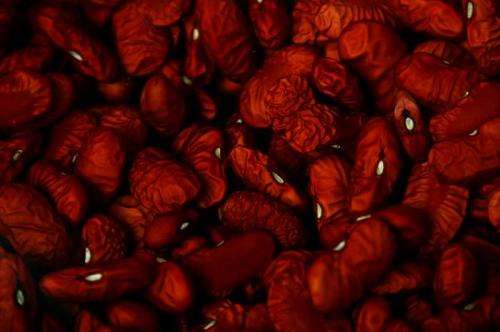Janine Higgins, PhD, shows that foods high in resistant starch, like these beans, can protect against colorectal cancer. Credit: Flickr/Bohman.
(Medical Xpress)—As the name suggests, you can't digest resistant starch so it ends up in the bowel in pretty much the same form it entered your mouth. As unlovely as that seems, once in the bowel this resistant starch does some important things, including decreasing bowel pH and transit time, and increasing the production of short-chain fatty acids. These effects promote the growth of good bugs while keeping bad bugs at bay. A University of Colorado Cancer Center review published in this month's issue of the journal Current Opinion in Gastroenterology shows that resistant starch also helps the body resist colorectal cancer through mechanisms including killing pre-cancerous cells and reducing inflammation that can otherwise promote cancer.
"Resistant starch is found in peas, beans and other legumes, green bananas, and also in cooked and cooled starchy products like sushi rice and pasta salad. You have to consume it at room temperate or below – as soon as you heat it, the resistant starch is gone. But consumed correctly, it appears to kill pre-cancerous cells in the bowel," says Janine Higgins, PhD, CU Cancer Center investigator and associate professor of Pediatrics at the University of Colorado School of Medicine.
Higgins describes studies showing that rats fed resistant starch show decreased numbers and sizes of lesions due to colorectal cancer, and an increased number of cells that express the protein IL-10, which acts to regulate the body's inflammatory response.
"Resistant starch may also have implications for the prevention of breast cancer," Higgins says. "For example, if you let rats get obese, get them to lose the weight, and then feed half of the rats a diet high in resistant starch – these rats don't gain back the weight as fast as rats fed a regular, digestible starch diet. This effect on obesity may help to reduce breast cancer risk as well as having implications for the treatment of colorectal cancer."
"There are a lot of things that feed into the same model of resistant starch as a cancer-protective agent," Higgins says. "Much of this information currently comes from rodent models and small clinical trials but the evidence is encouraging." On the table now is a menu of benefits and while it's just now being studied which benefits, exactly, will pan out as mechanisms of cancer prevention, one thing is clear: resistant starch should be on the menu.
More information: journals.lww.com/co-gastroente … ry_agent_for.15.aspx
Journal information: Current Opinion in Gastroenterology
Provided by University of Colorado Denver



















